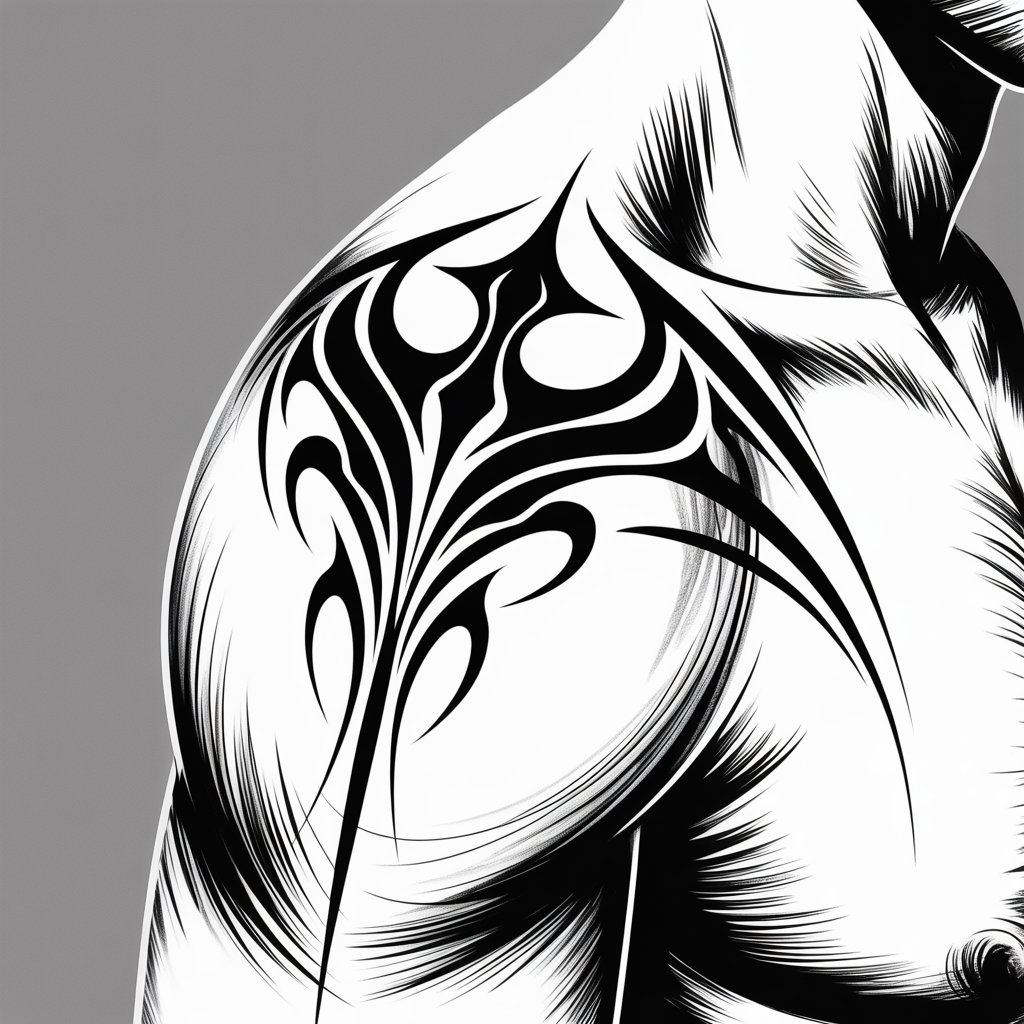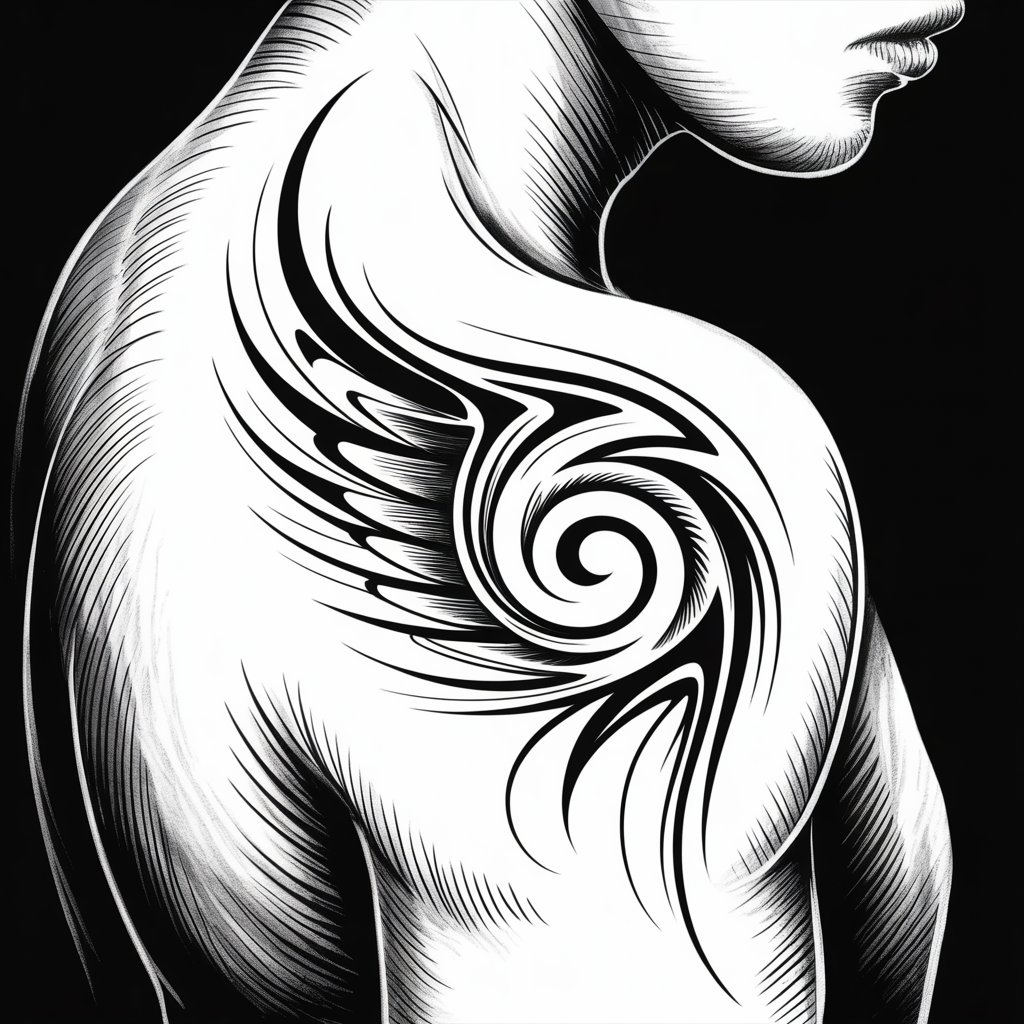In the vast landscape of tattoo artistry, certain designs transcend fleeting trends to become timeless expressions of human identity. The tribal wing tattoo stands among these enduring classics, blending ancient symbolic language with contemporary aesthetic sensibilities. This striking monochromatic design showcases why tribal-inspired body art continues to captivate both tattoo enthusiasts and artists alike.
The Visual Language of Tribal Artistry
The example featured here demonstrates the distinctive characteristics that define exceptional tribal tattoo work:
Fluid Dynamism
Notice how the design creates a sense of movement even in stillness. The sweeping curves and sharp points suggest a wing in motion, capturing the dynamic essence of flight in static form. This illusion of movement is a hallmark of masterful tribal design—the ability to make black ink seem to flow across the skin.
Balance of Positive and Negative Space
The artist has skillfully utilized negative space (the unmarked skin) as an integral part of the composition. The contrast between bold black lines and untouched skin creates a visual rhythm that draws the eye through the piece. This interplay between marked and unmarked space gives the design both boldness and breathability.
Strategic Placement
The shoulder blade provides an ideal canvas for this winged design, as the natural contours of the human body enhance the organic flow of the pattern. The placement allows the spiral center of the wing to anchor at the scapula while the extensions follow the natural musculature, creating harmony between body and art.
Symbolic Dimensions
Wing tattoos carry rich symbolic associations that often motivate their selection:
Freedom and Transcendence
Wings universally symbolize liberation from constraints—both physical and spiritual. They represent the human desire to rise above limitations and transform beyond current circumstances. For many wearers, a wing tattoo serves as a permanent reminder of personal freedom or commemoration of overcoming significant life challenges.
Protection and Guidance
In numerous cultural traditions, wings are associated with guardian spirits or protective forces. The positioning of this design on the upper back suggests a symbolic guardian presence watching over the wearer. The spiral center might represent the eye of awareness or consciousness that guides one’s journey.
Duality in Unity
The tribal style often incorporates elements of duality—sharp points balanced with smooth curves, aggressive angles with flowing lines. This visual duality can represent the integration of opposing aspects of self: strength and vulnerability, discipline and spontaneity, grounding and aspiration.
The Monochromatic Aesthetic
The commitment to pure black ink reflects a bold artistic choice with several advantages:
Timeless Aging
Black tribal work tends to age more gracefully than colored tattoos. The clean lines and solid blacks may soften over time but generally maintain their definition and impact decades after application.
Striking Contrast
The stark black-against-skin contrast creates a dramatic visual impact that commands attention while remaining sophisticated and versatile enough to complement various personal styles.
Visual Clarity
The absence of color forces the design to succeed purely on the strength of its form, composition, and execution. This places greater emphasis on the quality of linework and the overall balance of the piece.
The Evolution of Tribal Art
While tribal tattoos draw inspiration from indigenous art traditions of Polynesia, Micronesia, and other cultures with rich tattooing histories, contemporary tribal work represents an evolved art form:
From Traditional to Neo-Tribal
Today’s tribal tattoos often blend traditional motifs with modern aesthetic sensibilities. They honor ancestral forms while creating a visual language accessible to contemporary audiences. The simplified, abstracted forms retain the power of ancient symbols while speaking to current artistic tastes.
Personal Adaptation
Modern tribal designs like this wing are often customized to reflect the individual’s personal journey rather than strictly adhering to traditional cultural patterns. This personalization allows the wearer to connect with the aesthetic power of tribal art while creating a unique personal statement.

Considerations for Tribal Wing Tattoos
For those inspired by this design, several factors merit consideration:
Artist Selection
Tribal work demands technical precision and an understanding of how designs flow with the body’s contours. Seek artists who specialize in this style and can demonstrate strong portfolios of similar work.
Customization Potential
While this wing design is striking as shown, tribal motifs offer extensive customization possibilities. Consider personal elements that might be incorporated while maintaining the strong visual impact of the tribal aesthetic.
Placement Options
While the shoulder/upper back placement shown here is ideal for wing designs, similar motifs can be adapted for other body areas including:
- Upper arm and shoulder
- Side torso
- Lower back
- Calf or thigh
The Enduring Appeal
What explains the continued popularity of tribal designs decades after they first gained mainstream attention? Perhaps it’s their ability to communicate complex concepts through simplified forms, creating art that speaks on both conscious and subconscious levels. The tribal aesthetic strips away unnecessary details to reveal essential forms—much like how effective personal transformation often involves removing what’s non-essential to reveal one’s true nature.
For those drawn to the powerful visual language of tribal art, a wing design offers a compelling way to express aspirations of freedom, protection, and personal transcendence in a form that remains as visually striking as it is rich in potential meaning.
This article explores the artistic elements and symbolism of tribal wing tattoos. For those considering tribal body art, consulting with a tattoo artist who specializes in this distinctive style is essential to create a design that honors both the aesthetic tradition and your personal journey.


